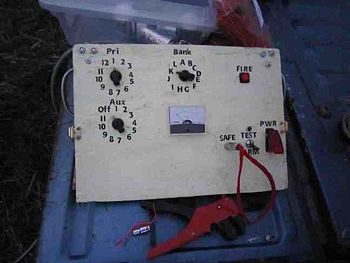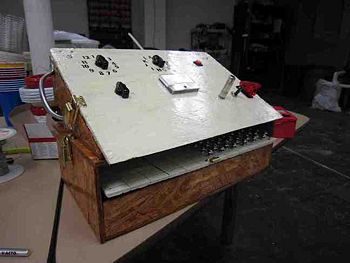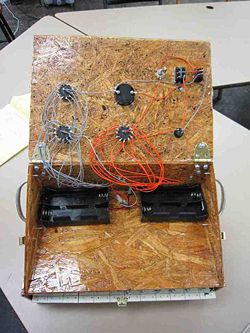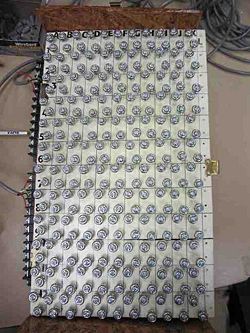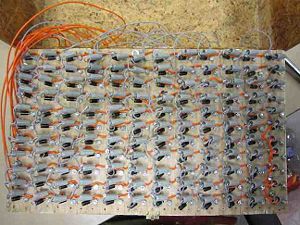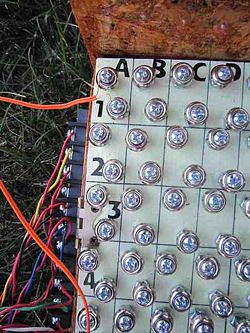Difference between revisions of "Electric firework firing system"
(New page: == Overview == I made this as an early birthday present for my father. Both he and his brother love their fireworks and do a pretty awesome show for the 4th every year. I wanted to do some...) |
|||
| Line 53: | Line 53: | ||
Something I found out after building this system is that professional firing systems have to ground the ignition wires when not in use to prevent stray RF interference from generating current on the wires and causing accidental ignitions. While the chances are pretty slim that this would happen, it's worth considering in future designs. | Something I found out after building this system is that professional firing systems have to ground the ignition wires when not in use to prevent stray RF interference from generating current on the wires and causing accidental ignitions. While the chances are pretty slim that this would happen, it's worth considering in future designs. | ||
| + | |||
| + | |||
| + | [[Category:dosman projects]] | ||
Latest revision as of 10:55, 25 September 2012
Contents |
[edit] Overview
I made this as an early birthday present for my father. Both he and his brother love their fireworks and do a pretty awesome show for the 4th every year. I wanted to do something nice for him and got interested in building an electric firing system. I had used nichrome wire to ignite fireworks in the past for one-off projects, but this scaled things up to a respectable level. I learned a lot about the pyro community and different designs available to use. In the end I really like how this project turned out, it has a home-made look to it, works great, and remains a compact unit for easy use by a hobbiest.
[edit] Some terminology
The firework scene has some unique terminology I was not aware of until I started hanging out on related forums:
- Cue - a single ignitor control, called a cue because the firework doesn't immediately launch, it just ignites the fuse when triggered
- Ignitor - one of several types of devices that converts electricity into heat or flame to start the firework
- Pyroclips - a trade-name for spring clips where the ignitor wires connect to the slat
- Slat - the junction box at the remote end of your firing system where the ignitors connect - can be hard wired or wireless
- Shooting wire - the wire that connects the ignitor to the slat, usually solid conductor and low gauge like 22 or less
- Talon ignitors / Falcon ignitors - trade names for nichrome clip-on ignitors
[edit] Design and Photos
I had a rough idea of how I wanted to build it, but I decided to do some research to see what other folks had done first. One of the main expenses in a hard-wired system is the wire itself, I wanted to find a clever way of reducing the number of wires running from your control box out to the fireworks. After some digging I found some folks using a diode-matrix design to reduce down the number of wires required by a good factor. One could also implement charlieplexing here to get even higher "wire-efficiency", but the complexity was not warranted for what I needed to achieve.
I found some 12 position rotary switches from Jameco and based the design around those. Two 12x12 switches using the diode matrix slat design yields a 144 cue firing system. The firing panel attaches to the top of the slat for easy transportation. I attempted to make my own pyroclips using finish washers sitting on springs. One thing not shown well in the photos is the 50' of 24 conductor wire (22 guage), it's nice to have a friend that works at the cyclotron :).
Most electric firing system designs use tons of switches, this is a minimalist's design using a single fire button in series with the 12 position switches. The Aux switch allows two cues on the same "bank" to be selected at once when fired. I used a 1/4" jack as a safety key, it's nice and heavy which makes it feel solid (and easy to replace if necessary). The test switch automatically runs low current through the ignitor which allows you to quickly cycle through positions noting if the lamp goes out. A lot of folks building firing systems use a pair of 12V sealed-lead-acid batteries for 24V, I just kept this design simple by using 8 D-cell batteries. There's also an auxillary power terminal strip on the outside as a backup power source. The white surfaces are glow in the dark, and lastly I ordered a bag of Falcon ignitors to finish the project off. I originally intended to just give my dad a spool of nichrome wire, but the clip-on ignitors are very cheap and WELL worth the cost. Sure you can manually wind nichrome on a couple fuses, but doing more than a couple dozen would easily take hours, and with hundreds of fireworks to launch, there's just no way to go with anything less than the clip-on's.
[edit] Further Reading and other designs
There's a bustling fireworks community online which I had no idea about until I started digging.
- www.RFRemotech.com - This site lists several interesting products and also has a schematic for the diode matrix I used in my design
- Falcon Ignitors - they changed their design shortly after I bought mine
- Fireworksland forums
- Pyro Universe forums
Something I found out after building this system is that professional firing systems have to ground the ignition wires when not in use to prevent stray RF interference from generating current on the wires and causing accidental ignitions. While the chances are pretty slim that this would happen, it's worth considering in future designs.
